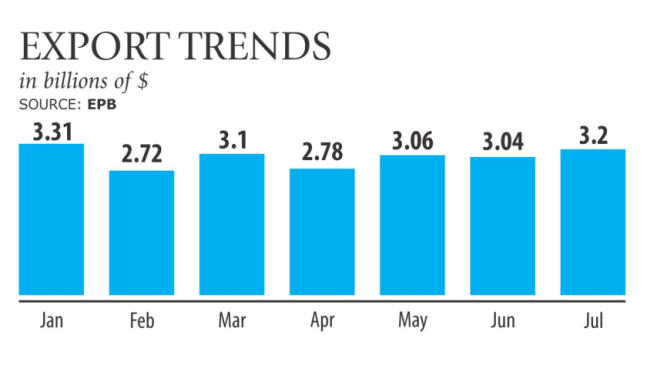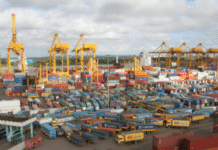Export earnings in July soared 26.54 percent to $3.2 billion, marking a strong rebound after lacklustre performance in the fiscal year that concluded in June.
July’s receipts, however, narrowly missed the monthly target of $3.23 billion, according to data from the Export Promotion Bureau.
The surge in exports was led by garment, whose shipments soared 17.08 percent year-on-year to $2.47 billion in July.
Still, the sector’s export earnings fell short of the monthly target by 5 percent.
Siddiqur Rahman, president of the Bangladesh Garment Manufacturers and Exporters Association, though is not too sanguine about July’s performance.

“The large growth shown in July was due to lower volume of shipments a year earlier,” he said, adding that last month’s earning growth might not sustain all year round.
In a single month the export figure can surge for many reasons. “It is difficult to predict the future based on a single month’s earnings.”
The near-term export outlook of the garment sector, which typically contributes 82 percent to Bangladesh’s total export earnings, is not too rosy for the nervy global economic situation, he said.
Besides, Bangladesh has been losing its edge to competitors for longer lead-time due to inefficient Chittagong port operations, he said.
“The other competing countries are performing well because of the efficiency of their port operations and for having better infrastructure.”
Bangladesh’s apparel exports to the European Union grew only 3.49 percent to $17.75 billion in fiscal 2016-17. In case of the US, the country’s single largest export destination, it declined 7.47 percent to $5.2 billion.
Saiful Islam, president of Leathergoods and Footwear Manufacturer and Exporter’s Association of Bangladesh, attributed the surge in shipments to Christmas, the preparation of which starts from July and wraps up in the middle of September.
From September onwards, the retailers start stocking the products on their shop floors, Islam said.
This year, the export of leather goods might not grow at the same pace as in July due to the shift of factories from Hazaribagh to Savar.
Of the 155 relocated leather factories, the majority could not start their production due to a lack of gas connection, he said.
Last month, leather and leather goods exports grew 26.19 percent year-on-year to $116.73 million.
Some other sectors have also performed well in July.
Frozen and live fish exports grew 57 percent to $59.42 million, pharmaceuticals 23.29 percent to $7.20 million, home textile 60.31 percent to $63.77 million and footwear 84.08 percent to $25.20 million.
However, the earning from the promising jute and jute goods sector slid 7.51 percent to $64.53 million.
Source: The Daily Star









